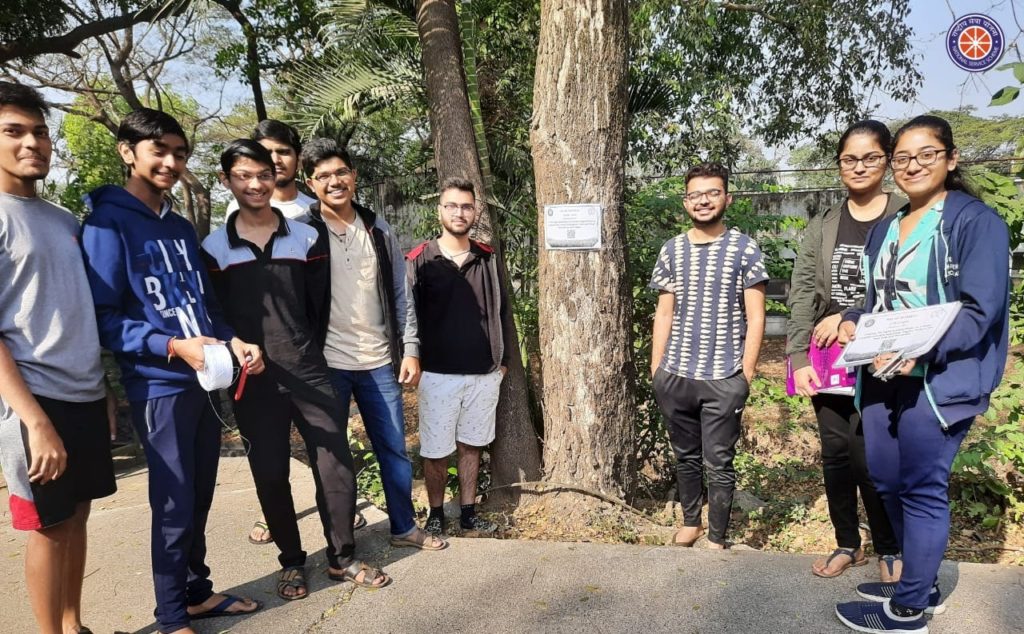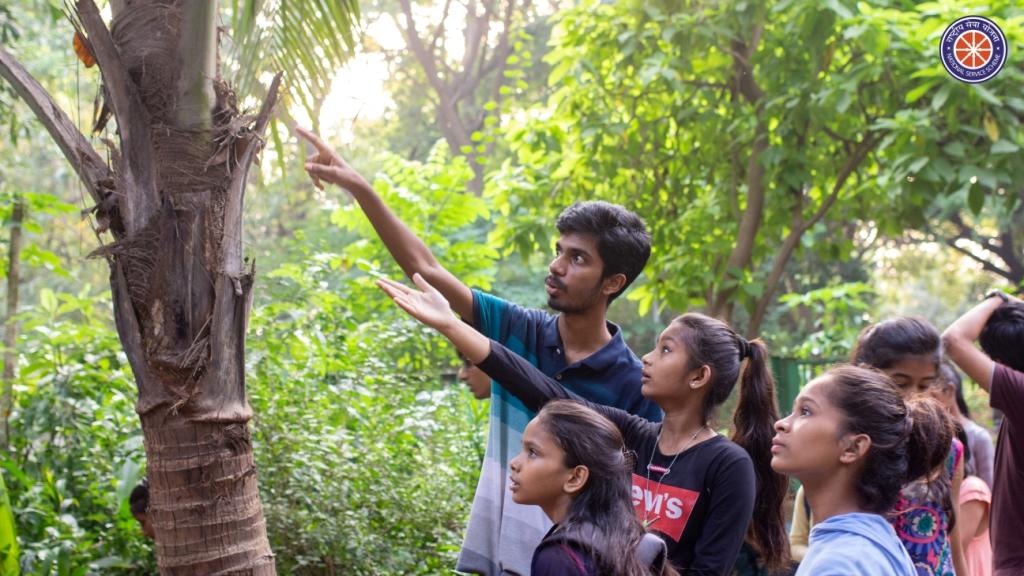NSS team members, IIT Bombay: Top row (left to right) Jahanvi Akanksha, Tejaswini Narwade and Vaibhavi Agrawal; Middle row (left to right): Shaan Ul Haque, Shubham Varankar, Saieesh Jirwankar, Yatendra Gupta. Bottom row (left to right): Hari Krishna Sai and Kushank Jaiswal.
Whenever one visits the IIT Bombay campus, the thing that can never go unnoticed is the green cover in the midst of the metropolitan city. Our institute being blessed by such great floral diversity, we at Green Campus NSS IIT Bombay put in dedicated efforts in binding together humans with this nature.
If you do ever have a walk along the roadsides, the white placards on the trees are something that catches everyone’s eye. Four years ago when there were none of these, no one ever bothered to notice the greenery. With a vision to make people stand by these trees and make them appreciate the resources we have in the institute, the team of Green Campus department of NSS IIT Bombay went on identifying the species of the trees on several routes in the Institute. Within a few weeks, all those trees had a placard that identified the tree.
The activity was then praised a lot by the entire institute as well as it gained attention from the leading newspapers such as The Hindustan Times, The Hindu, etc. With such an immensely positive response and the efforts of the extremely enthusiastic volunteers of Green Campus, to date, we have mapped about 1600+ trees in the institute covering as many as 60+ species in different parts of the institute in the Biodiversity mapping initiative. These placards provide information about the tree consisting of its name, the scientific name as well a piece of crisp one-line information about it. Placards over different species provide the visitors, students, professors or green activists divert their attention towards the trees and learn some facts related to that tree. The initiative has thus proved to be a major step in binding nature and humans together.

Over the years, we did feel that just the one-line information was attractive but was not sufficient for gratifying the viewers. The love for the initiative from the audience encouraged us to work on an online platform to cater to the needs of the viewers and make them feel connected to the vast biodiversity in the institute. Two years later, on the occasion of World Environment Day (6th June), we launched our ‘Greenopedia’, which basically is the Wikipedia of plants present in the Institute.
The ‘Greenopedia’ website consists of information about 80+ species of trees present all over the institute and is a perfect blend of a crisp description of not only the tree but also its fruits, flower, stem, seeds, etc. as well as a few distinct features of the tree which help in its identification. Not only the description but the Greenopedia also contains the location of the trees of all the species mapped over the years by our team. The website also contains a short video description made by our volunteers for all the species present there.
But that’s not all that we do. Here are some of our other initiatives.
Nature Walk
To inculcate a sense of attachment with nature among the young generation, we conduct nature walk for the kids of NGOs in Mumbai, who don’t get an opportunity to connect with nature being a part of the metropolitan environment. Volunteers of Green Campus conduct a nature walk throughout the Institute for the kids telling them about the biodiversity present in our institute as well as the importance of what is its significance.

Green Diwali
Diwali has become more of a festival of air pollution than that of lights. With a vision for a sustainable future, we aim at celebrating Green Diwali in NSS wherein we make diyas out of the waste fruit peels obtained from the mess as well as lanterns out of the waste plastic bottles generated in the canteens. We believe in not using crackers and pollute the environment but rather we should light the life of someone who needs it.

Birds of IIT Bombay
IIT Bombay has been blessed with great diversity among the birds, not only native but the migrating species as well. The diversity along with no much information about it encouraged us to come up with a platform that contains information about all the bird species that are seen at some point in time of the year in the institute. This gave rise to the ‘Birds of IIT Bombay’ website which is a database of more than 95 species of birds in our institute. The website hosts information about the common names, biometrics, global population trend, call and lot more interesting facts about these birds.
A Sapling a Wing
Nowadays people are getting aware of the damage that humans have done to the earth and the environment. Especially college students nowadays are getting very active to do any contribution they can for mother nature. Thus we came up with the idea of gifting every student in a hostel with a sapling which they will nurture. Also, looking at the number of waste plastic bottles generated every day at the canteens and mess in the institute, we thought of using these bottles to plant sampling inside them. This idea received a lot of appreciation from all students in the hostels.

Sapling Collection Drives
IIT Bombay, being in a tropical region, is blessed with immense showers during the months of June to September. The rain gifts us with small, baby saplings of large varieties all over the institute. Taking this as an opportunity, the Green campus department conducts a Sapling collection drive in the institute where we collect the baby Saplings of trees and plants and we plant them in the sapling covers which are made from the waste and leftover flexes of events. This has been seen as the remarkable latitude to feed our nursery with new plants and received a lot of appreciation.
We hope you have enjoyed reading Fundamatics, the award-winning ezine published by the IIT Bombay Alumni Association, envisioned as one that is by IIT Bombay alumni, faculty and students, and for the same vast community. And, the best part of Fundamatics is that it is completely free and can be accessed by thousands of our alumni who are spread all over the world. But this does not mean that we do not incur any operational costs in bringing the ezine to you. Your financial support can mean that we can continue to remain in circulation and “free” to you, our readers.
